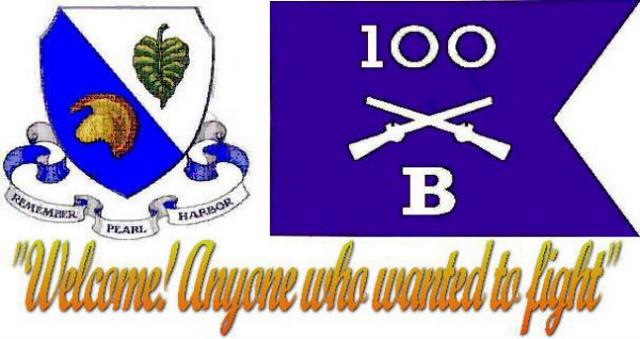
Reenactment Group "BCo/100Bn""
このページは、管理人「先任」の趣味としているWWⅡリエナクトの写真を掲載しています。
無断転載は禁じますが、興味を持たれた方のページへのリンク、シェアは歓迎しています。
各個戦闘動作
このページではWW2期のアメリカ陸軍で使用されたFM(FieldManual=野戦教範)を元に兵士が学んだ戦闘時の動作の一部について解説します。もちろんこの動作でなければならない、と言う事ではなく戦闘時の諸動作は地形や状況によって様々に変化します。しかし、変化すると言うのは基本動作ができている場合に初めて生じるものであり、WW2期に従軍した兵士達は基本としてこれらを訓練で叩き込まれています。
動作、と言うのは再現が難しい部分でもありますが他の再現項目に比べてとても大きなメリットがあります。
それはお金が一切かからない、という点です。
実物はもちろん再現度の高い被服や装備、徽章などはそれなりにお金を支払わなければ普通は入手できませんが、動作に関してはちょっとした場所と時間、そして適切な教育があればタダで身に付ける事ができるのです。
今回はアメリカ陸軍のFM21-75「SCOUTING, PATOROLLING, AND SNIPING」の中から各兵士が戦闘時に多用する動作を一部抜き出して解説します。
なお、このFMには他にも多種多様な項目が掲載されておりますが、その全てを翻訳し解説するのはなかなか困難ですのでご了承下さい。

1944年版 FM21-75「SCOUTING, PATOROLLING, AND SNIPING」 拝借元の馬好き伍長さんに感謝します!
FMのPART-1「SCOUTING=斥候」の中のChapter-2「Scouting by day=昼間斥候」のSection-Ⅱ「Movement=移動」の項目に歩兵(他職種についても同様)の斥候時の行動に関する事が記されています。
これらは斥候時はもちろん、攻撃やあらゆる戦闘時に適用されます。
原文と翻訳(私が意訳してる部分もありますのでご了承下さい)、図によって示しています。
是非、リエナクト等における各個動作に生かしていただければ、と思います。
Section II. MOVEMENT
セクションⅡ。 移動
8. PRINCIPLES OF MOVEMENT.
8.移動の原則。
a. The scout moves from one concealed location to another. When not changing his position he remains motionless. The fire of light automatic weapons makes the above more important than ever before.
a・斥候が隠れた場所から別の場所に移動する際について。
移動しない場合、姿勢は変えません。
軽自動火器の射撃に対して、上記はこれまで以上に重要になりました。
b. To observe, he lifts his head slowly yet steadily, and without abrupt movements.
b・観察する際は頭をゆっくりと着実に、急な動作はせずに持ち上げます。
c. From each position he selects his next stopping place. He avoids isolated, conspicuous places of concealment. Before leaving one position he must make certain that his next stopping place does not contain an enemy. Every location from which the enemy may observe must be considered as actually occupied by the enemy.
c・次の移動先を選定します。 孤立した目立つ隠蔽場所は避けます。
移動を開始する前に、彼は次の位置に敵がいないことを確認する必要があります。 敵が観察する可能性のあるすべての場所は、実際に敵に占領されていると見なす必要があります。
d. When changing position by running he must spring up, run with body bent low, and drop to the earth quickly. Advantage must always be taken of walls, ditches, or similar cover. If close to the enemy, a slight rise may enable the scout to advance even closer by creeping or crawling.
d。 走って位置を変えるとき、跳ね上がるように走り出し、体を低く曲げて走り、素早く地面に落ちなければなりません。
壁、溝、または同様のカバーを常に利用する必要があります。
敵に近い場合は匍匐(クリープやクロール)によって斥候はさらに近くへ進むことができます。
9. AIDS TO MOVEMENT.
移動時の注意点
a.
(1) A scout should carry only necessities. Additional weight causes premature fatigue and impedes free movement.
斥候は必需品のみを運ぶ必要があります。追加の重量は早すぎる疲労を引き起こし、自由な動きを妨げます。
(2) A scout should not disturb birds or animals whose flight would betray his presente. If the scout should alarm birds or animals, he remains motionless under cover for a few minutes as attention may have been attracted to his position.
斥候は自分に動きに干渉する鳥や動物を邪魔してはならない。鳥や動物の行動が自身の位置を暴露する可能性がある場合、斥候は自身に位置に注意が向けられている可能性を考慮し、数分間は隠蔽下で動かないように。
(3) Any incident which diverts attention, such as an airplane flight, a distant disturbance, or sudden bursts of fire, diverts observation from the scout. He moves during such incidents.
航空機の飛行、遠方の騒音、突然の爆発など、注意をそらす出来事は、敵の見張りの観察をそらす効果があります。そのような事象の間に移動します。
(4) Fog or even light haze offers concealmtent for movement.
霧または光のかすみは、動きを隠します。
(5) When in the presence of the enemy, it is best to swim a body of water at night. If necessary to do so in the daytime, a small raft for concealing the head may be made with a few sticks or brush and tufts of grass. In any case, the scout should try to improvise a float for his rifle and equipment.
敵がいる場合、夜間に水域を泳ぐのが最善です。昼間にそうする必要がある場合、頭を隠すための小さないかだは、いくつかの棒またはブラシと草の房で作られます。いずれにせよ、斥候はライフルと装備のためにフロートを即興で作るべきです
(6) A scout moving along a beach should keep close to the water's edge. The waves and spray will help to conceal him from a boat offshore, and to wash away his footprints.
砂浜に沿って移動する斥候は水際に近接して下さい。
波と飛沫は、沖のボートから隠し、彼の足跡を洗い流すのに役立ちます。
(7) When in tall grass or similar growth, the scout should move when the wind blows, changing direction frequently, as a straight route will be noticed more readily.
背の高い草地または同様の生育地では、風が吹く時に行動し、頻繁に方向を変える事。
まっすぐなルートは簡単に発見されます。
(8) He should avoid making tracks wherever possible, especially in snow.
可能な限り、特に雪の中は足跡を作ることを避けるべきです。
(9) In returning to his own lines, the scout avoids the route used in going out.斥候は味方の陣に戻る際、攻撃に使用するルートを避けなければいけません。
(10) In crossing a road the scout selects a position with shadows, or near a bend, and crosses rapidly in a low position.
道路を横断する際、斥候は影になる、または曲がりくねった位置を選択し、低い姿勢で急速に横断します。
(11) In crossing a plowed field the scout follows the length of the furrow to avoid the bobbing movement caused by crossing the furrows.
耕された畑を横切る際、斥候は溝の長さに従い、溝を横切ることによって生じる揺れ動きを避けます。
b. Prone position.
伏せの姿勢

図4
The body is flat. The left cheek is on the ground. The legs are extended and spread. The heels, turned in, touch the ground. If the rifle is carried, it is grasped in the right hand at the balance, muzzle to the front, operating handle up. (See fig. 4.)
体を平たくします。左の頬を地面に向け、脚は伸ばして広げます。
かかとを回転させ地面につけます。小銃を携帯する場合は、右手で銃の重心を握り、前方に銃口を向け、オペレーティングハンドルを上向きにします。
(図4を参照)
c. Rushing from prone position. See figure 5.
伏せの姿勢からの早駆け。図5を参照してください。

図5-1
①The soldier starts the rush from the prone position.
伏せの姿勢からの早駆けを開始します。

図5-2
②He slowly raises his head to select a new position.
ゆっくりと頭を上げ、向かうべき位置を選定します。

図5-3
③He slowly lowers his head, draws arms inward, and cocks the right
les forward, preparing to rush.
ゆっくり頭を下げ、腕を内側に引きつけ、右脚を前方に曲げて発進できるようにします。早駆けが速やかにできる体勢を取ります。

図5-4
④with one movement, he raises his body by straightening his arms.
一回の動作で、腕をまっすぐにして体を持ち上げます。
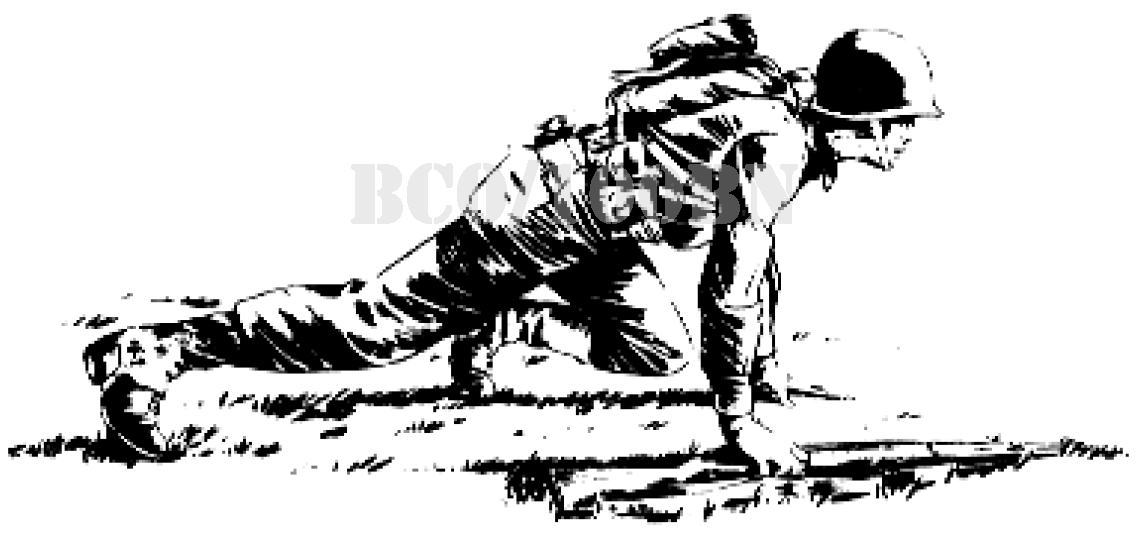
図5-5
⑤He springs to his feet, stepping of with his left foot.
足で地面を蹴って跳ね上がり、左足から前方に出します。

図5-6
⑥ He runs foward in a straight line, crouched low,to the new position.
まっすぐに前方へ駆け、低くしゃがんで新しい位置に付きます。
d. Dropping to prone position. See figure 6.
伏せの姿勢へ。 図6を参照してください。

図6-1
①The soldier plants both feet in place.
両足を所定の位置に置いて立ちます。
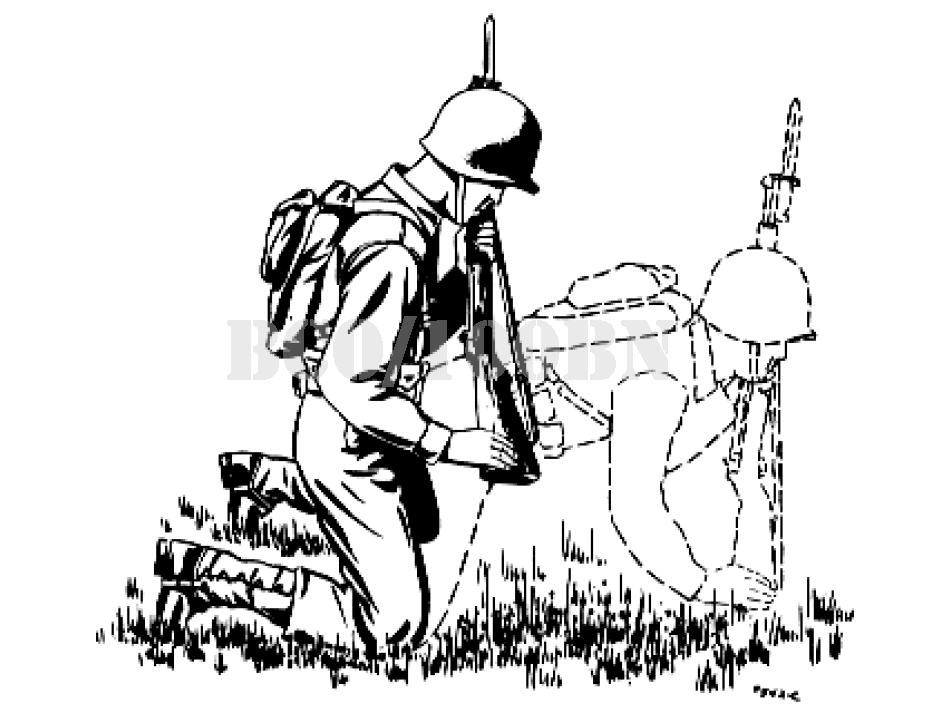
図6-2
②He drops to his knees, and at the same time slides his hand to the
heel of his rifle.
両膝を地面につけると同時に手をスライドして、小銃の「かかと」に添わせます。

図6-3
③He falls forward, breaking the fall with the butt of his rifle.
小銃で衝撃を吸収しなが、前方に倒れこみます。

図6-4
④He then rolls into the firing position, or lies as flat us possible on the ground. if he thinks he has been observed, and concealment exists. he moves a short distance toward a flank, moving in the most
practicable manner.
その後射撃位置に転がるか、地面にできるだけ平らに横たわります。
もし発見された場合は、側面に向かって短い距離を移動し、最も実用的な方法で移動し隠蔽します。
e. Creeping. See figure 7.
匍匐(クリーピング法) 図7を参照して下さい。

図7-1
①The body is kept free of the ground, and the weight of the body rests on the forearms and lower legs. The rifle is cradled in the arms, so that the muzzle is kept out of the dirt. Knees must be kept well behind the buttocks.
体は地面から自由に保たれ、体の重量は前腕と下肢にかかっています。 小銃は腕に支えられているため、銃口は汚れから保護されています。 膝は臀部の後ろでしっかりと保持する必要があります。

図7-2
②The soldier moves forward by alternately advancing the elbow's and knees. The left elbow is advanced at the same time as the right knee.
肘と膝を交互に前進させて前進します。 左肘は右膝と同時に前進します。

図7-3
③in creeping, the soldier presents a higher silhouette than in
crawling, but movement is faster.
クリーピング法はクロール法よりも姿勢が高く(発見されやすく)なりますが、動きは速くなります。
f. Crawling. See figure 8.
匍匐(クロール法) 図8を参照して下さい。

図8-1
①The body is as flat as possible against the ground. The cheek is flat against the ground. The rifle is carried at the balance, or dragged along on the toe of the butt with the thumb or forefinger over the muzzle. Care must be taken to keep the rifle muzzle out of the dirt
身体は地面に対して可能な限り平で、 頬も地面に対して平らにします。
小銃は重心を保持されるか、または親指または人差し指で銃口を塞ぎ、銃床の先を地面につけて引きずられます。
銃口を汚れから守るために注意が必要です
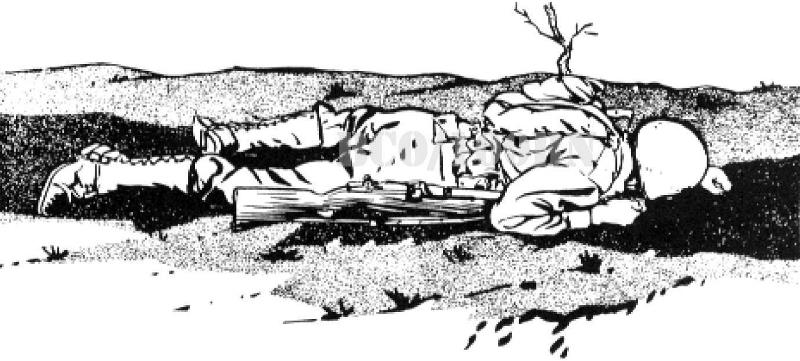
図8-2
②To move forward, the soldier pushes his arms forward and cocks one leg forward.
腕を前に押し出し、片足を前方に曲げます。
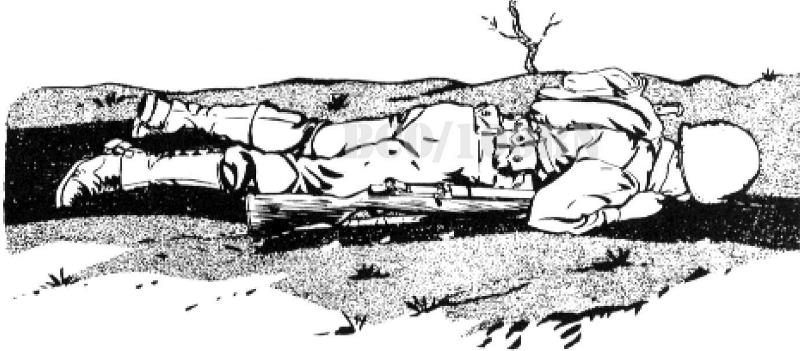
図8-3
③He pralls himself forward with his arms and pushes with the
forward leg.
腕で前方に引きずり、同時に前足で押します。

図8-4
④The soldier may move by pushing with one leg only, or may move faster (but be more exposed) by alternately pushing with either leg.
片方の足で押すだけで移動することも可能ですが、交互に脚を使ってに押すことでより速く動くこともできます
(ただし、より露出します)。
・上に戻る